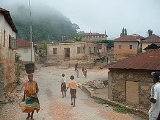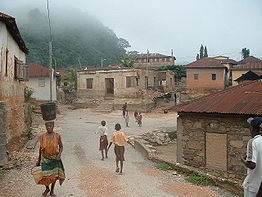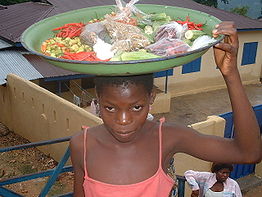
Logba language
Encyclopedia
Logba is a Kwa language spoken in the south-eastern Ghana
by approximately 7 500 people. The Logba people
call themselves and their language Ikpana, which means ‘defenders of truth’. Logba is different from Lukpa
of Togo
and Benin
, which is also sometimes referred to as Logba.
(1903). Westermann included Logba in his group of Togo Restsprachen (Togo Remnant languages), a terminology adopted by several subsequent researchers. Dakubu and Ford (1988) renamed this cluster the Central Togo languages but since Ring (1995) they are commonly referred to as Ghana–Togo Mountain languages. The about fourteen Ghana–Togo Mountain languages are part of the Kwa
branch of the Niger–Congo
phylum.

 The Logba people live in the Volta Region
The Logba people live in the Volta Region
of Ghana, east of the Volta Lake in the mountains of the Ghana–Togo borderland. Most Logba towns and villages are situated along the trunk road from Accra to Hohoe. They include the following settlements: Wuinta, Akusame, Adiveme, Andokɔfe, Adzakoe, Alakpeti, Klikpo, and Tota. Tota is located high in the Ghana–Togo Mountains to the east of the Accra–Hohoe road. Alakpeti is the commercial centre of Logba, while Klikpo is traditionally the seat of the head of the Logba people. The Logba people are primarily subsistence farmers, producing cassava, maize, yams and forest fruits, supplemented by cash crops like cocoa, coffee and sawn mahogany logs. The Logba area is known for its scenery, which includes waterfalls, cliffs, and limestone
formations, including one or two known small caves with minor speleothems.
The dominant language in the region is Ewe
, closely followed by Twi. Most Logba people are bilingual in Ewe. South of the Logba area live the Avatime people. Logba is only distantly related to its direct neighbours Avatime
and Nyagbo-Tafi; according to Bernd Heine
(1968) it is more closely related to the Akpafu and Santrokofi languages spoken northwards.
It is generally agreed that the Logba people are not the original inhabitants of the area they now reside in. There have been two hypotheses as to the origin of the Logba people. Heine (1968, following Debrunner), proposed that the Logba are descendants from the makɔ́ people, having fled south after a defeat in the second half of the 18th century.
system with ATR
vowel harmony
. Vowel harmony in Logba is root-controlled, which means that the vowels of its nominal prefixes harmonize with the vowels of the root. Vowels are nasalized when they occur in the immediate environment of a nasal consonant.
Logba has a total of 23 consonants. A notable feature of Logba phonology is the opposition between bilabial and labio-dental fricatives, found in various other languages of the region, including Ewe
. Logba is a tonal language with two level tones: High and Low. These tones can be combined on one syllable, yielding a Rising or Falling contour tone.
All syllable
s are open in Logba. Every syllable bears a tone. The basic syllable structure can be rendered as (C1)(C2)V+T, where C = consonant, V = vowel or syllabic nasal, and T = tone. Dorvlo (2004) distinguishes three types of syllables:
Ghana
Ghana , officially the Republic of Ghana, is a country located in West Africa. It is bordered by Côte d'Ivoire to the west, Burkina Faso to the north, Togo to the east, and the Gulf of Guinea to the south...
by approximately 7 500 people. The Logba people
Logba people
The Logba people live in the Volta Region of Ghana, east of the Volta Lake in the mountains of the Ghana-Togo borderland. Most Logba towns and villages are situated along the trunk road from Accra to Hohoe. They include the following settlements: Wuinta, Akusame, Adiveme, Andokɔfe, Adzakoe,...
call themselves and their language Ikpana, which means ‘defenders of truth’. Logba is different from Lukpa
Lukpa language
Lukpa is a Gur language spoken in Benin and Togo....
of Togo
Togo
Togo, officially the Togolese Republic , is a country in West Africa bordered by Ghana to the west, Benin to the east and Burkina Faso to the north. It extends south to the Gulf of Guinea, on which the capital Lomé is located. Togo covers an area of approximately with a population of approximately...
and Benin
Benin
Benin , officially the Republic of Benin, is a country in West Africa. It borders Togo to the west, Nigeria to the east and Burkina Faso and Niger to the north. Its small southern coastline on the Bight of Benin is where a majority of the population is located...
, which is also sometimes referred to as Logba.
Classification
The first published treatment of Logba was a short grammar by Diedrich Hermann WestermannDiedrich Hermann Westermann
Diedrich Hermann Westermann was a German missionary, Africanist, and linguist. He substantially extended and revised the work of Carl Meinhof, his teacher, although he rejected some of Meinhof's theories only implicitly...
(1903). Westermann included Logba in his group of Togo Restsprachen (Togo Remnant languages), a terminology adopted by several subsequent researchers. Dakubu and Ford (1988) renamed this cluster the Central Togo languages but since Ring (1995) they are commonly referred to as Ghana–Togo Mountain languages. The about fourteen Ghana–Togo Mountain languages are part of the Kwa
Kwa languages
The Kwa languages, often specified as New Kwa, are a proposed but as-yet-undemonstrated family of languages spoken in the south-eastern part of Côte d'Ivoire, across southern Ghana, and in central Togo...
branch of the Niger–Congo
Niger–Congo languages
The Niger–Congo languages constitute one of the world's major language families, and Africa's largest in terms of geographical area, number of speakers, and number of distinct languages. They may constitute the world's largest language family in terms of distinct languages, although this question...
phylum.
Geography and demography


Volta Region
Volta Region is one of Ghana's ten administrative regions. It is to the east of Lake Volta. Its capital is Ho.-List of districts:The region has 18 districts consisting of 3 municipal and 15 ordinary districts:-Background:...
of Ghana, east of the Volta Lake in the mountains of the Ghana–Togo borderland. Most Logba towns and villages are situated along the trunk road from Accra to Hohoe. They include the following settlements: Wuinta, Akusame, Adiveme, Andokɔfe, Adzakoe, Alakpeti, Klikpo, and Tota. Tota is located high in the Ghana–Togo Mountains to the east of the Accra–Hohoe road. Alakpeti is the commercial centre of Logba, while Klikpo is traditionally the seat of the head of the Logba people. The Logba people are primarily subsistence farmers, producing cassava, maize, yams and forest fruits, supplemented by cash crops like cocoa, coffee and sawn mahogany logs. The Logba area is known for its scenery, which includes waterfalls, cliffs, and limestone
Limestone
Limestone is a sedimentary rock composed largely of the minerals calcite and aragonite, which are different crystal forms of calcium carbonate . Many limestones are composed from skeletal fragments of marine organisms such as coral or foraminifera....
formations, including one or two known small caves with minor speleothems.
The dominant language in the region is Ewe
Ewe language
Ewe is a Niger–Congo language spoken in Ghana, Togo and Benin by approximately six million people. Ewe is part of a cluster of related languages commonly called Gbe, spoken in southeastern Ghana, Togo, and parts of Benin. Other Gbe languages include Fon, Gen, Phla Phera, and Aja...
, closely followed by Twi. Most Logba people are bilingual in Ewe. South of the Logba area live the Avatime people. Logba is only distantly related to its direct neighbours Avatime
Avatime language
Avatime, also known as Afatime, Sideme, or Sia, is a Kwa language of the Avatime people of eastern Ghana...
and Nyagbo-Tafi; according to Bernd Heine
Bernd Heine
Bernd Heine is a German linguist and specialist in African studies.From 1978 to 2004 Heine held the chair for African Studies at the University of Cologne, Germany. His main focal points in research and teaching are African linguistics, language sociology, grammaticalization theory and language...
(1968) it is more closely related to the Akpafu and Santrokofi languages spoken northwards.
It is generally agreed that the Logba people are not the original inhabitants of the area they now reside in. There have been two hypotheses as to the origin of the Logba people. Heine (1968, following Debrunner), proposed that the Logba are descendants from the makɔ́ people, having fled south after a defeat in the second half of the 18th century.
Phonology
Logba has a nine vowelVowel
In phonetics, a vowel is a sound in spoken language, such as English ah! or oh! , pronounced with an open vocal tract so that there is no build-up of air pressure at any point above the glottis. This contrasts with consonants, such as English sh! , where there is a constriction or closure at some...
system with ATR
Advanced tongue root
In phonetics, advanced tongue root and retracted tongue root, abbreviated ATR or RTR, are contrasting states of the root of the tongue during the pronunciation of vowels in some languages, especially in West Africa, but also in Kazakh and Mongolian...
vowel harmony
Vowel harmony
Vowel harmony is a type of long-distance assimilatory phonological process involving vowels that occurs in some languages. In languages with vowel harmony, there are constraints on which vowels may be found near each other....
. Vowel harmony in Logba is root-controlled, which means that the vowels of its nominal prefixes harmonize with the vowels of the root. Vowels are nasalized when they occur in the immediate environment of a nasal consonant.
| . | Front Front vowel A front vowel is a type of vowel sound used in some spoken languages. The defining characteristic of a front vowel is that the tongue is positioned as far in front as possible in the mouth without creating a constriction that would be classified as a consonant. Front vowels are sometimes also... | Central Central vowel A central vowel is a type of vowel sound used in some spoken languages. The defining characteristic of a central vowel is that the tongue is positioned halfway between a front vowel and a back vowel... | Back Back vowel A back vowel is a type of vowel sound used in spoken languages. The defining characteristic of a back vowel is that the tongue is positioned as far back as possible in the mouth without creating a constriction that would be classified as a consonant. Back vowels are sometimes also called dark... |
|---|---|---|---|
| Near-close Near-close vowel A near-close vowel is a type of vowel sound used in some spoken languages. The defining characteristic of a near-close vowel is that the tongue is positioned similarly to a close vowel, but slightly less constricted. Near-close vowels are sometimes described as lax variants of the fully close vowels... |
ɪ | ʊ | |
| Open-mid Open-mid vowel An open-mid vowel is a type of vowel sound used in some spoken languages. The defining characteristic of an open-mid vowel is that the tongue is positioned two-thirds of the way from an open vowel to a mid vowel... |
ɛ | ɔ | |
| Open Open vowel An open vowel is defined as a vowel sound in which the tongue is positioned as far as possible from the roof of the mouth. Open vowels are sometimes also called low vowels in reference to the low position of the tongue... |
a |
| . | Front Front vowel A front vowel is a type of vowel sound used in some spoken languages. The defining characteristic of a front vowel is that the tongue is positioned as far in front as possible in the mouth without creating a constriction that would be classified as a consonant. Front vowels are sometimes also... | Central Central vowel A central vowel is a type of vowel sound used in some spoken languages. The defining characteristic of a central vowel is that the tongue is positioned halfway between a front vowel and a back vowel... | Back Back vowel A back vowel is a type of vowel sound used in spoken languages. The defining characteristic of a back vowel is that the tongue is positioned as far back as possible in the mouth without creating a constriction that would be classified as a consonant. Back vowels are sometimes also called dark... |
|---|---|---|---|
| Close Close vowel A close vowel is a type of vowel sound used in many spoken languages. The defining characteristic of a close vowel is that the tongue is positioned as close as possible to the roof of the mouth without creating a constriction that would be classified as a consonant.This term is prescribed by the... |
i | u | |
| Close-mid Close-mid vowel A close-mid vowel is a type of vowel sound used in some spoken languages. The defining characteristic of a close-mid vowel is that the tongue is positioned two-thirds of the way from a close vowel to a mid vowel... |
e | o | |
| Open Open vowel An open vowel is defined as a vowel sound in which the tongue is positioned as far as possible from the roof of the mouth. Open vowels are sometimes also called low vowels in reference to the low position of the tongue... |
a |
Logba has a total of 23 consonants. A notable feature of Logba phonology is the opposition between bilabial and labio-dental fricatives, found in various other languages of the region, including Ewe
Ewe language
Ewe is a Niger–Congo language spoken in Ghana, Togo and Benin by approximately six million people. Ewe is part of a cluster of related languages commonly called Gbe, spoken in southeastern Ghana, Togo, and parts of Benin. Other Gbe languages include Fon, Gen, Phla Phera, and Aja...
. Logba is a tonal language with two level tones: High and Low. These tones can be combined on one syllable, yielding a Rising or Falling contour tone.
All syllable
Syllable
A syllable is a unit of organization for a sequence of speech sounds. For example, the word water is composed of two syllables: wa and ter. A syllable is typically made up of a syllable nucleus with optional initial and final margins .Syllables are often considered the phonological "building...
s are open in Logba. Every syllable bears a tone. The basic syllable structure can be rendered as (C1)(C2)V+T, where C = consonant, V = vowel or syllabic nasal, and T = tone. Dorvlo (2004) distinguishes three types of syllables:
- Nucleus only, consisting of a vowel or a syllabic nasal. This type is found only in pronouns and nominal prefixes. Examples: ɛ́-mɔ́ 'they laughed'; ɔ́-zɔ́ 'he/she went'; n-dà 'liquor'.
- Onset and nucleus. This is the most common syllabe type in Logba; most words are of this form. In multisyllabic words, it can occur in all positions. Examples: bà ‘come’; gbà ‘sweep’; bìsí ‘cola nut’
- Complex onset and nucleus. Only /r/ and /l/ occur as the second consonant of the complex onset. This syllable type can also form a word by itself. In multisyllabic words, in can occur in all positions. Examples: à-klɔ́ ‘goat’; trò ‘refuse’; ìvàflí ‘(thing) white’.
External links
- Ethnologue report on Logba
- Logba on the Rosetta Project
- The Southern Ghana-Togo Mountain Groups: A description of their languages and cultural heritage. (CNWS research project).
- :Image:Logbakitchen.JPG Picture of a family kitchen in Logba
- :Image:Lobgaschool.JPG Picture of Logba School
- :Image:Logbavillage.JPG Picture of Logba Village

